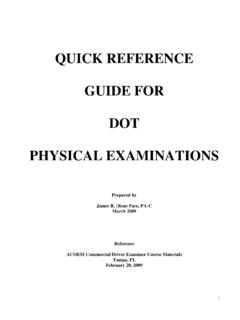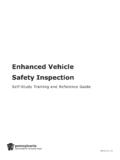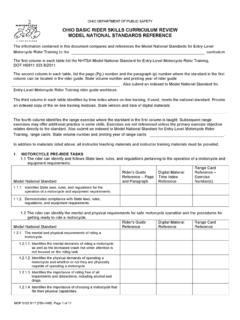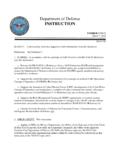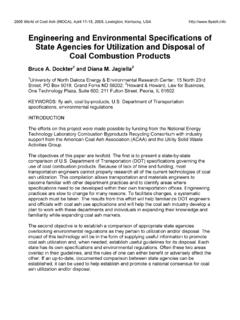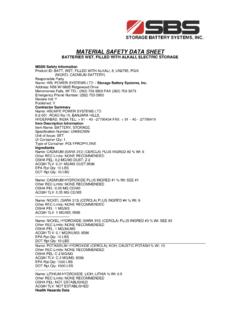Transcription of QUICK REFERENCE GUIDE FOR DOT PHYSICAL EXAMINATIONS
1 1 QUICK REFERENCE GUIDE FOR DOT PHYSICAL EXAMINATIONS Prepared by James R. (Ron) Pace, PA-C March 2009 REFERENCE ACOEM Commercial Driver Examiner Course Materials Tampa, FL February 20, 2009 2 The following information is taken from the course materials provided at the ACOEM Commercial Driver examination Course given February 20th, 2009. It is summarized to provide a QUICK REFERENCE source for questions that may arise while performing a DOT PHYSICAL examination . These are the current guidelines. Further recommendations may be pending by expert panels but have not been approved by the FCMSA. Driver s Duties may include: Coupling and uncoupling trailers from tractors Loading and unloading Inspecting vehicle and trailers Lifting, installing, and removing chains and tarps Driver must be able to: Bend and stoop Maintain couching position to inspect Frequent entering and exiting a cab Ability to climb ladders Driver must have: Perceptual skills to monitor complex driving situation Judgment skills to make QUICK decisions Manipulative skills to control an oversize steering wheel, shift gears, and maneuver vehicle in crowded areas Dishonest responses Deliberate omission or falsification of information may invalidate the examination and any certificate issued based on it.
2 Subject to civil penalty for making false statement or for concealing a disqualifying condition, 49 USC 521(b)(2)(c) HIPAA FMCSA does not prohibit employers from obtaining copies of the form Employers must comply with state and federal laws regarding privacy of employee medical information Authorization is required to release long form Guidelines Should be followed Guidelines are not law fut meant to serve as standard of care. Guidelines have been issued by the FMCSA and based on medical literature FMCSA goal is not to prevent drivers from working but ensure safe roads for all 3 RED FLAGS A. Visual Conditions/Diseases 1. low vision 20/200 to 20/50 2. diabetic retinopathy 3. glaucoma 4. retinitis pigmentosa 5. monocular vision 6. macular degeneration 7.
3 Nystagmus 8. visual field defects B. Cardiovascular Disease 1. cardiac arrhythmias if associated with cerebral ischemia 2. artificial cardiac pacemakers if associated with cerebral ischemia 3. hypertrophic cardiomyopathy 4. congestive heart failure if associated with cerebral ischemia 5. valvular heart disease if associated with cerebral ischemia C. Cerebrovascular Disease 1. CVA stroke 2. TIA D. Diseases of the Nervous System 1. Narcolepsy 2. Sleep apnea E. Respiratory Diseases 1. COPD associated with resp failure/cognitive impairment/generalized hypoxia 2. Respiratory failure F. Metabolic Diseases 1. Hypothyroidism with cognitive defects 2. Diabetes G. Renal Disease 1. Chronic renal failure with cognitive defect H. Dementia 1. Progressive Dementias I.
4 Psychiatric Diseases 1. Schizophrenia 2. Personality Disorders 3. Chronic alcohol abuse 4J. Medications chronic use 1. Antidepressants espec. TCAs 2. Antihistamines older ones 3. Any drug with prominent central nervous system effects analgesics, some antihypertensives, sedatives, hypnotics, anxyiolytics, benzodiazepines, stimulants Neurologic Automatic Disqualifying Conditions (Recommended) Legally incompetent Major psych disorder Aphasia, alexia Dementia Hemi-anopsia/neglect of VA Constructive apraxia Amnestic problems Frontal lobe disorders Chrnic cluster Has Migraines with neuro deficits Diplopia, oscillopsia Hemineglect, R-L Cranial neuralgia Menier s disease Labrynthine fistula Nonfunctioning labyrinth Cerebrovascular Diseases TIA No driving within one year Subsequent clearance by neurologist Transient global ischemia H&P EEG Psych eval Thrombotic/Embolic CVA Brainstem/ cerebellum no driving within one year Other areas no driving within 5 years Neuro exam Recertify annually Anticoagulants and antipressants disqualify Traumatic Brain Injury Careful eval before diriving Recertify annually 5 Dementias Decline in any mental domain.
5 Or any illness where dementia is common is disqualifying Disqualified if diagnosed even if only entertained Alzheimers Picks Parkinsonism stable may appeal Huntingtons Progressive supranuclear palsy Metabolic encephalopathy Drug/chemical dementia Depression Korsakoffs syndrome Tumore/CVA/MS with dementia Neuromuscular Diseases Motor neuron diseases disqualify Perepheral neuropathies disqualify Neuromuscular junction disease disqualified Muscular dystrophy, dermatomyositis, metabolic muscle disease, congential myopathies- disqualify CNS Tumor Disqualify Treated benign tumors may appeal Headaches Chronic or incapacitating MAY be disqualifying Medication use may be problematic Vertigo BPV requalify after 2 months w/o symptoms Acute /chronic vestibulopathy same Menieres and other chronic disqualify Seizures Uncontrolled epilepsy disqualify Controlled epilepsy disqualify History of seizure disorder qualified if off meds and no seizure for 10 years History of one seizure off meds and no seizure for 5 years Febrile seizure no restrictions 6 Narcolepsy Disqualifying Neuro or Psych Regulatory Issues Mental conditions that can affect judgement.
6 Perceptions of reality and reaction time mayu be disqualifying Medication side effects may necessitate disqualification Conditions that impair the ability to control a vehicle may ne disqualifying Strongly recommend neurology, psychiatry, or neuropsych eval for any CNS insult Anorexia nervosa and bulimia may be disqualified Personality disorders may be disqualified (aggressive driving increased) Medications NOT qualified Anxiolytics -BZD Hypnotics Barbiturates TCAs Antipsychotics Medications May be qualified Buspirone Amitriptyline 25 mg HS Fluoxetine Bupropion Stable on lithium > 3 months after ECT Valproic acid Cabamazepine Alcohol Current clinical diagnosis of alcoholism is disqualifying Pulmonary Conditions / Sleep Apnea If the medical examiner detects a respiratory dysfunction that in any way is likely to interfere with the driver s ability to safely control and drive a CMV, then the driver must be referred to a specialist for further evaluation and therapy.
7 Anticoagulation therapy is not disqualifying once the optimal dose is set, and there is normal lower extremity vasculature. Use of oxygen therapy while driving is disqualifying. 7 Sleep Apnea Sleep apnea is disqualifying until ruled out or treated successfully, agree to continue uninterrupted therapy, monitoring and objective testing. Obstructive sleep apnea unqualified till treated, then one month wait, then yearly multiple sleep latency testing or repeat sleep study. If surgically treated there is a 3 month wait. A driver with probable sleep apnea with Excessive Daytime Somnolence (EDS) should be temporarily disqualified until evaluated and successfully treated. Secondary Pulmonary Conditions DVT and Pulmonary PE unqualified unless on anticoagulation therapy and have normal LE venous studies (no clots) and acceptable PFTs, stable for 3months after PE and stable for 1 month after DVT.
8 Lung Cancer Unqualified if: Severe cough Dyspnea Wasting Hypoxemia Metastatic brain disease Qualified if cure after resection and no symptoms. If stable and under treatment, monthly monitoring. Undergoing radiation: Meet PFT criteria Asymptomatic Monitored every 3 months for two years then yearly for five years. Obstructive Sleep Apnea (OSA) Medical Expert Panel (MEP) recommends immediate disqualification if driver has EDS or fall asleep crash. Needs eval and treatment MEP recommends if BMI > 33 then a one month conditional certification until sleep study is done to confirm diagnosis. Need report from sleep study that shows effective treatment and no evidence of EDS. Questionnaires are subjective. Gold standard is the polysomnogram in a sleep lab.
9 8 MSLT Multiple Sleep Latency Test Series of naps every 2 hours Usually preceded by sleep diary and polysomnogram Measure sleepiness NOT routinely indicated in eval or diagnosis of OSA MWT Maintenance of Wakefulness Test Series of naps every 2 hours Stay awake for 40 minutes Used to assess ability to stay awake in low stimulation condition Falling asleep in less than 8 min. abnormal, 8-40 min questionable significance Treatment CPAP Surgery Treatment with Provigil (Modafinil) May not drive or do any activity that requires mental alertness until they know how the drug affects them. Many side effect and drug interactions that may affect concentration, function and hides signs of fatigue and tiredness. Musculoskeletal Issues PHYSICAL requirements to operate a CMV: grip strength neck range of motion shoulder girdle strength prolonged sitting and riding enter and exit cab repeatedlyh tie down loads tire chains PHYSICAL exam: inspect and note deformities ranges of motion ability to change posture readily gait heel/toe walk strength shoulder girdle, grasp and squat.
10 Skill Performance Evals Missing or impaired limbs Ability to safely operate a CMV Examiner indicates need for SPE Eval needed by orthopedist or physiatrist Get SPE at State Service Center after application completion 9 Gastrointestinal Nothing absolutely disqualifying Main concerns are often related to complications of therapy/complications of medications Abdominal findings sufficient to interfere with normal function as in injuries, hernia, or functional symptoms like IBS, ulcers, etc. Genitourinary Conditions Nothing absolutely disqualifying Main likely disqualifier dialysis Consider temporary disqualification for renal colic or prostatitis Chronic Kidney Disease (CKD) No regulations specifically address CMV drivers with CKD Drivers with CKD are susceptible to fatigue; daytime sleepiness; neurocognitive symptoms; increased risk of cardiovascular events; frequently have DM also.
